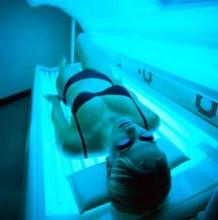Four out of 10 people in Germany reported ever using a tanning bed, according to the results of a recent population-based survey published online Oct. 15 in Archives of Dermatology.
The overall prevalence of tanning bed use was 39.2%, "and every seventh person ... had used a sunbed during the last 12 months," reported Sven Schneider, Ph.D., of the Mannheim Institute of Public Health, Heidelberg University (Germany), and his associates. "These findings emphasize the urgent need for standardized education of sunbed personnel by independent (not sunbed industry-associated) institutions."
Data on the prevalence of tanning bed use and on the behavior patterns associated with its use are "unavailable or limited," which is surprising because the prevalence and behavior patterns associated with exposure to other known carcinogens, such as tobacco and alcohol, "are studied and monitored extensively," reported Dr. Schneider and his colleagues. They sought "to obtain a more comprehensive overview of the current state of sunbed use in Germany."
They assessed 4,851 people aged 14-45 years using an anonymous telephone survey during both summer and winter months. The study population was equally divided between males and females, and the mean study patient age was 31 years. Of the participants, 32% reported having Fitzpatrick skin type I or II, 35% reported a Fitzpatrick skin type of III, and 28% reported having skin type IV. Skin types V and VI are rare in Germany, the researchers noted.
Tanning bed use was more common in people aged 18-25 years (mean prevalence, 21.4%) than in other age groups (mean prevalence, 12.6%). And women were more likely than were men to have ever used a tanning bed (49% vs 29.8%) or to be using tanning beds currently (17.7% vs 11.7%).
People used tanning beds predominantly in tanning salons (74.9%), fitness centers (10.1%), or at swimming pools/sauna facilities (7.9%). They were less likely to use tanning beds at home (3.8%), in hotels (1.5%), beauty salons (0.7%), or medical facilities (0.6%).
Among current users, 68.2% said that "advisory personnel" were present at their most recent visit. Only 41% of users reported use of protective goggles at their most recent visit, and 40% said they had never been advised to wear protective goggles.
Over 40% of current tanning bed users said they had never been given advice about skin type, and approximately 73% said they had never been informed about the potential health risks of tanning bed use. More than one-third of respondents who had Fitzpatrick type I or II skin had used a tanning bed at least once.
Seventy percent said they had not been asked by personnel about medications, skin care products, or skin disorders that may have contraindicated the use of a tanning bed. And nearly 78% of users said they had not received an individual tanning plan based on their skin type.
The most important reasons given for using tanning beds were for relaxation, to improve physical attractiveness, to "pretan" before vacation, and "the desire for a feeling of warmth." Other reasons given somewhat frequently were "for health care" and "vitamin D supplementation." Tanning bed personnel routinely failed to inform clients that these reasons "are not medically sound," Dr. Schneider and his associates reported (Arch. Dermatol. 2012 Oct. 15 [doi:10.1001/2013.jamadermatol.562]).
The study population may have been unusual in that a large proportion of the tanning bed users already had somewhat dark skin (Fitzgerald types III or higher). Also, results of the study showed that immigrants were more likely to use tanning beds. "This association might be explained by beauty ideals of users with a Turkish heritage: Turks represent the largest group of immigrants in Germany," wrote Dr. Schneider and colleagues.
The study was supported by the German Cancer Aid. No financial conflicts of interest were reported.


